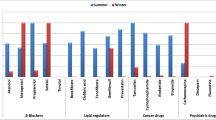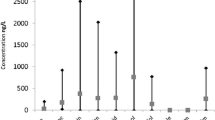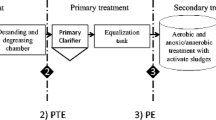Abstract
Pharmaceutically active compounds in wastewater released from human consumption have received considerable attention because of their possible risks for aquatic environments. In this study, the occurrence and removal of 10 pharmaceuticals in three municipal wastewater treatment plants in southern China were investigated and the environmental risks they posed were assessed. Nifedipine, atenolol, metoprolol, valsartan and pravastatin were detected in the influent wastewater. The highest average concentration in the influents was observed for metoprolol (164.6 ng/L), followed by valsartan (120.3 ng/L) in August, while median concentrations were higher in November than in August. The total average daily mass loadings of the pharmaceuticals in the three plants were 289.52 mg/d/person, 430.46 mg/d/person and 368.67 mg/d/person, respectively. Elimination in the treatment plants studied was incomplete, with metoprolol levels increasing during biological treatment. Biological treatment was the most effective step for PhACs removal in all of the plants studied. Moreover, the removal of PhACs was observed with higher efficiencies in August than in November. The WWTP equipped with an Unitank process exhibited similar removals of most PhACs as other WWTPs equipped with an anoxic/oxic (A/O) process or various anaerobic-anoxic-oxic (A2/O) process. The environmental risk assessment concluded that all of the single PhAC in the effluents displayed a low risk (RQ<0.1) to the aquatic environments.

Similar content being viewed by others
References
Backhaus T, Scholze M, Grimme L H (2000). The single substance and mixture toxicity of quinolones to the bioluminescent bacterium Vibrio fischeri. Aquatic Toxicology (Amsterdam, Netherlands), 49(1-2): 49–61
Behera S K, Kim H W, Oh J E, Park H S (2011). Occurrence and removal of antibiotics, hormones and several other pharmaceuticals in wastewater treatment plants of the largest industrial city of Korea. Science of the Total Environment, 409(20): 4351–4360
Brennan P J, Greenberg G, Miall W E, Thompson S G (1982). Seasonal variation in arterial blood pressure. British Medical Journal (Clinical Research Ed.), 285(6346): 919–923
Göbel A, Thomsen A, McArdell C S, Joss A, Giger W (2005). Occurrence and sorption behavior of sulfonamides, macrolides, and trimethoprim in activated sludge treatment. Environmental Science & Technology, 39(11): 3981–3989
Hernando M D, Mezcua M, Fernández-Alba A R, Barceló D (2006). Environmental risk assessment of pharmaceutical residues in wastewater effluents, surface waters and sediments. Talanta, 69(2): 334–342
Huang Q, Yu Y, Tang C, Zhang K, Cui J, Peng X (2011). Occurrence and behavior of non-steroidal anti-inflammatory drugs and lipid regulators in wastewater and urban river water of the Pearl River Delta, South China. Journal of Environmental Monitoring, 13(4): 855–863
Huerta-Fontela M, Galceran M T, Ventura F (2011). Occurrence and removal of pharmaceuticals and hormones through drinking water treatment. Water Research, 45(3): 1432–1442
Kasprzyk-Hordern B, Dinsdale R M, Guwy A J (2009). The removal of pharmaceuticals, personal care products, endocrine disruptors and illicit drugs during wastewater treatment and its impact on the quality of receiving waters. Water Research, 43(2): 363–380
Khan S J, Ongerth J E (2002). Estimation of pharmaceutical residues in primary and secondary sewage sludge based on quantities of use and fugacity modelling. Water Science and Technology, 46(3): 105–113
Kosma C I, Lambropoulou D A, Albanis T A (2014). Investigation of PPCPs in wastewater treatment plants in Greece: occurrence, removal and environmental risk assessment. Science of the Total Environment, 466-467(1): 421–438
Lolić A, Paíga P, Santos L H M L, Ramos S, Correia M, Delerue-Matos C (2015). Assessment of non-steroidal anti-inflammatory and analgesic pharmaceuticals in seawaters of North of Portugal: Occurrence and environmental risk. Science of the Total Environ-ment, 508(3): 240–250
Lv M, Sun Q, Hu A, Hou L, Li J, Cai X, Yu C P (2014). Pharmaceuticals and personal care products in a mesoscale subtropical watershed and their application as sewage markers. Journal of Hazardous Materials, 280: 696–705
Papageorgiou M, Kosma C, Lambropoulou D (2016). Seasonal occurrence, removal, mass loading and environmental risk assessment of 55 pharmaceuticals and personal care products in a municipal wastewater treatment plant in Central Greece. Science of the Total Environment, 543(A): 547–569
Peng X, Ou W, Wang C, Wang Z, Huang Q, Jin J, Tan J (2014). Occurrence and ecological potential of pharmaceuticals and personal care products in groundwater and reservoirs in the vicinity of municipal landfills in China. Science of the Total Environment, 490 (8): 889–898
Quinn B, Gagné F, Blaise C (2009). Evaluation of the acute, chronic and teratogenic effects of a mixture of eleven pharmaceuticals on the cnidarian, Hydra attenuata. Science of the Total Environment, 407 (3): 1072–1079
Radjenović J, Petrović M, Barceló D (2009). Fate and distribution of pharmaceuticals in wastewater and sewage sludge of the conventional activated sludge (CAS) and advanced membrane bioreactor (MBR) treatment. Water Research, 43(3): 831–841
Roberts J, Kumar A, Du J, Hepplewhite C, Ellis D J, Christy A G, Beavis S G (2016). Pharmaceuticals and personal care products (PPCPs) in Australia’s largest inland sewage treatment plant, and its contribution to a major Australian river during high and low flow. Science of the Total Environment, 541(1): 1625–1637
Rosal R, Rodríguez A, Perdigón-Melón J A, Petre A, García-Calvo E, Gómez M J, Agüera A, Fernández-Alba A R (2010). Occurrence of emerging pollutants in urban wastewater and their removal through biological treatment followed by ozonation. Water Research, 44(2 2SI): 578–588
Subedi B, Kannan K (2015). Occurrence and fate of select psychoactive pharmaceuticals and antihypertensives in two wastewater treatment plants in New York State, USA. Science of the Total Environment, 514(5): 273–280
Sui Q, Huang J, Deng S, Chen W, Yu G (2011). Seasonal variation in the occurrence and removal of pharmaceuticals and personal care products in different biological wastewater treatment processes. Environmental Science & Technology, 45(8): 3341–3348
Sun Q, Lv M, Hu A (2014). Seasonal variation in the occurrence and removal of pharmaceuticals and personal care products in a wastewater treatment plant in Xiamen, China. Journal of Hazardous Materials, 277(SI): 69–75
United State Environmental Protection Agency (USEPA) (2007). EPA Method 1694: Pharmaceuticals and Personal Care Products in Water, Soil, Sediment, and Biosolids by HPLC/MS/MS
Verlicchi P, Al Aukidy M, Zambello E (2012). Occurrence of pharmaceutical compounds in urban wastewater: Removal, mass load and environmental risk after a secondary treatment–a review. Science of the Total Environment, 429: 123–155
Verlicchi P, Galletti A, Petrovic M, Barceló D (2010). Hospital effluents as a source of emerging pollutants: An overview of micropollutants and sustainable treatment options. Journal of Hydrology (Amsterdam), 389(3–4): 416–428
Vieno N, Tuhkanen T, Kronberg L (2007). Elimination of pharmaceuticals in sewage treatment plants in Finland. Water Research, 41(5): 1001–1012
Wang J, Zhang L, Wang F, Liu L, Wang H, and the China National Survey of Chronic Kidney Disease Working Group (2014). Prevalence, awareness, treatment, and control of hypertension in China: Results from a national survey. American Journal of Hypertension, 27(11): 1355–1361
Yan Q, Gao X, Chen Y P, Peng X Y, Zhang Y X, Gan X M, Zi C F, Guo J S (2014a). Occurrence, fate and ecotoxicological assessment of pharmaceutically active compounds in wastewater and sludge from wastewater treatment plants in Chongqing, the Three Gorges Reservoir Area. Science of the Total Environment, 470-471(2): 618–630
Yan Q, Gao X, Huang L, Gan X M, Zhang Y X, Chen Y P, Peng X Y, Guo J S (2014b). Occurrence and fate of pharmaceutically active compounds in the largest municipal wastewater treatment plant in Southwest China: Mass balance analysis and consumption backcalculated model. Chemosphere, 99(3): 160–170
Yuan X, Qiang Z, Ben W, Zhu B, Qu J (2015). Distribution, mass load and environmental impact of multiple-class pharmaceuticals in conventional and upgraded municipal wastewater treatment plants in East China. Environmental Science. Processes & Impacts, 17(3): 596–605
Acknowledgements
This study was financially supported by China’s National Natural Science Fund (No. 51578555) and the Research Funding Program of Guangdong Provincial Key Laboratory of Environmental Pollution Control and Remediation Technology (No. 2016K0006).
Author information
Authors and Affiliations
Corresponding authors
Electronic supplementary material
Rights and permissions
About this article
Cite this article
Huang, H., Wu, J., Ye, J. et al. Occurrence, removal, and environmental risks of pharmaceuticals in wastewater treatment plants in south China. Front. Environ. Sci. Eng. 12, 7 (2018). https://doi.org/10.1007/s11783-018-1053-8
Received:
Revised:
Accepted:
Published:
DOI: https://doi.org/10.1007/s11783-018-1053-8




